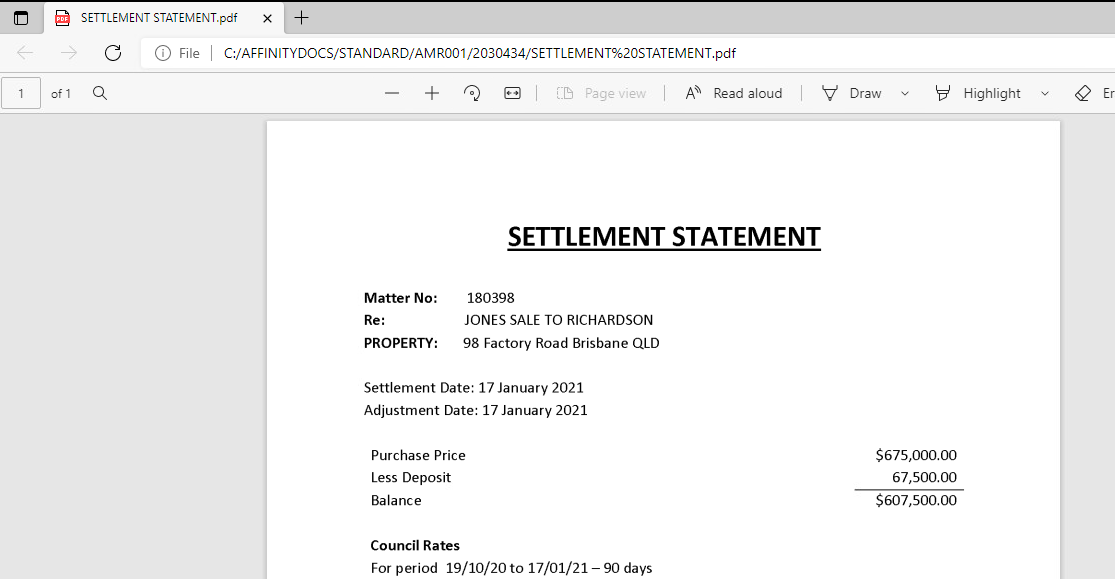LexisNexis Affinity
This document only provides information on how to configure the EzeScan LexisNexis Affinity Connector settings.
For information on EzeScan please refer to the EzeScan website - https://ezescan.com.au
For information on Lexis Nexis solutions please refer to the Lexis Nexis website - https://www.lexisnexis.com.au
LexisNexis Prerequisites
The EzeScan LexisNexis Affinity connector uses the LexisNexis Affinity Rest API. It is required to be installed and running prior to EzeScan configuration.
The LexisNexis Affinity Desktop Client is required if you want to view the files that EzeScan has placed into LexisNexis Affinity.
Requires use and prior knowledge of EzeScan 5.0
NOTE
The LexisNexis Affinity Connector has been designed for use withe EzeScan 5.0. It is assumed that the operator has read about, or is familiar with EzeScan Job, KFI and UPLOAD modules. If not please refer to the specific EzeScan PRO, KFI and UPLOAD guides. It is also assumed that the operator is experienced with the LexisNexis Affinity product.
Requires a valid EzeScan LexisNexis Affinity License
NOTE
It is a prerequisite that the EzeScan Workstation has been been licensed for the use of the EDRMS, KFI and UPLOAD modules, along with the LexisNexis Affinity connector. Without a valid trial license or production license with these features enabled the LexisNexis Affinity connector can't be configured or used.

Configuring LexisNexis Affinity Connection Settings in EzeScan
The first thing that needs to be setup is to define the connection settings to talk to your instance of LexisNexis Affinity.
There are several ways that can be used to configure these settings with the Affinity connector.
Method 1. Configure the LexisNexis Affinity Connection settings once in the Admin → Workstation Options form.
When configuring a Job, KFI or Upload to use the LexisNexis Affinity connector the connection settings panel must be filled in.
- Open the EzeScan Admin → Workstation Options menu option. The Workstation Options form is displayed.
- Click the EDRMS tab and choose the LexisNexis Affinity option from the drop down list that appears.

3. Enter the following information:
Field | Description |
|---|---|
| Service URL | Enter the URL of your LexisNexis Affinity server. |
| Username | Enter the LexisNexis Affinity username you want to logon as. |
Password | Enter the password for the user. |
Note: If only connecting to the one server, it is strongly recommended that the LexisNexis Affinity connection settings are configured globally as above.
This saves you from having to setup the EDRMS connection details in each and every individual KFI and UPLOAD. that your job/route is using.
Method 2. Configure the LexisNexis Affinity Connection settings within a KFI
Note: If only connecting to the one server, it is strongly recommended that the LexisNexis Affinity connection settings are configured globally.
When configuring a KFI to use the LexisNexis Affinity connector the connection settings panel must be filled in.
- Open the EzeScan Admin -> KFI menu option. The KFI admin form is displayed.
- Choose the EDRMS tab. Select the LexisNexis connector to display the LexisNexis Affinity Server Settings

3. Deselect the 'Use Global Settings' option. It should be not be ticked when specifying settings at the KFI module level.
4. Configure these settings
Field | Description |
|---|---|
| Service URL | Enter the URL of your LexisNexis Affinity server. |
| Username | Enter the LexisNexis Affinity username you want to logon as. |
Password | Enter the password for the user. |
Method 3. Configure the LexisNexis Affinity Connection settings within an UPLOAD
Note: If only connecting to the one server, it is strongly recommended that the LexisNexis Affinity connection settings are configured globally.
When configuring an UPLOAD to use the LexisNexis Affinity connector the connection settings panel must be filled in.
- Open the EzeScan Admin -> Upload menu option. The Upload admin form is displayed.
- The Upload to property will be set to use the LexisNexis Affinity connector.
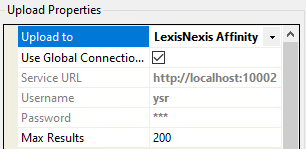
3. Deselect the 'Use Global Settings' option. It should be not be ticked when specifying settings at the UPLOAD module level.
4. Configure these settings
Field | Description |
|---|---|
| Service URL | Enter the URL of your LexisNexis Affinity server. |
| Username | Enter the LexisNexis Affinity username you want to logon as. |
Password | Enter the password for the user. |
Configuring LexisNexis Affinity Import and Profiling in Jobs
The current version of the LexisNexis Affinity connector does not offer support for Import From EDRMS functionality with LexisNexis Affinity.
The current version of the Lexis Nexis Affinity connector does not offer a job level profile form because the Lexis Nexis Affinity API does not provide one, hence the requirement to use a Job + KFI + Upload instead..
Configuring LexisNexis Affinity Browsing in KFI Fields
The KFI Field Settings allow the operator to browse into LexisNexis Affinity during KFI indexing so the operator can then select folders and object types to be applied to the document.
Configuring LexisNexis Affinity browse functionality
This step assumes that you have already setup the Lexis Nexis Affinity Server Settings either in the Workstation Options form EDRMS settings or in the KFI Admin form EDRMS settings.
Use the Admin→KFI form to select a KFI field to modify. On the Field properties form use the EDRMS tab to configure the type of browse or search of LexisNexis Affinity to use.
Browse Mode

This option determines the type of LexisNexis Affinity Browser that is shown when the Browse button (F3) is pressed during indexing.
Choose from one of the following options:
Option | Description |
|---|---|
| Enable | When ticked, enables the LexisNexis Affinity Button on the EzeScan Viewer KFI indexing panel. |
| Action Type | Available options are: Search Clients Search Document Profiles Search Document Types Search Documents Search Employees Search Matters Search Phone Books Depending on the Action Type various Browse property settings can be configured as below |
| Search Properties | The properties that can be set for a search are:
|
Configuring Lexis Nexis field metadata mapping in UPLOAD
The UPLOAD module will obtain the KFI output data to pass into LexisNexus Affinity saving the document into the respective folder and applying metadata information.
This step assumes that you have already setup the LexisNexis Affinity Server Settings either in the Workstation Options form EDRMS settings or in the UPLOAD Admin form settings.
Use the Admin→UPLOAD form to select a UPLOAD to modify. On the Upload form make sure the 'Upload To' property is set to LexisNexis Affinity.
Mapping Source Field values into the required Target LexisNexis Affinity Fields
The following fields will appear after choosing Upload To LexisNexis Affinity option in the Upload Properties pane. These are the default LexisNexis Affinity fields.
Each target field can have its input mapped from the source field cell.
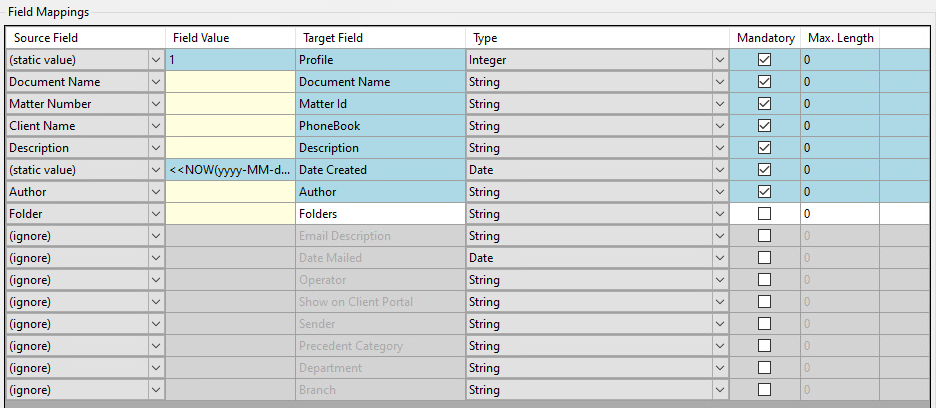
The target field can get its data from a number of sources:
- It's mapped to a source field (i.e. one of the KFI fields defined in the associated Job+KFI+Upload set).
- It's using a static value , that has either been typed into the source field value column (or browse using a browse button shown to the right hand side of the field value entry box.
The top 7 field target fields highlighted in blue in the Field Mapping grids are mandatory, so data must be passed into those field values.
The Folders target field is optional.
The lower grayed out field mapping are not configured and are considered to be disabled.
Here's a brief explanation of what each target field is expecting to receive
Target Field | Description |
|---|---|
| Profile | Is expecting the profile type. It's been set to use a static value of 1. |
| Document Name | Is expecting the name of document (i.e. title, description) that will be applied to the scanned document. It's been populated using the KFI Document Name field value. |
| Matter Id | Is expecting the GUID value of the Matter id that will be applied to scanned document. It's been populated using the KFI 'Matter Number' field value. |
| PhoneBook | Is expecting the client name. It's been populated using the KFI 'Client Name' field value. |
| Description | Is expecting the description. It's been populated using the KFI 'Description' field value. |
| Date Created | Is expecting a valid date value. It's been populated using the a system placeholder that returns todays date. |
| Author | Is the name of the author who create the document. It's been populated using the KFI 'Author' field value. |
| Folders | Is expecting the name of a folder to place the document into. It's been populated using the KFI 'Folder' field value. This connector's API does not allow the option for -Missing sub folders are automatically created when they don't already exist.- |
Configuring the whole Job+KFI+Upload Process
Building an entire EzeScan Job+KFI+UPLOAD is not within the scope of this connector guide.
This connector guide is designed to give an experienced EzeScan user the additional knowledge required to configure the LexisNexis Affinity connector.
What is the easiest way to get a working LexisNexis Affinity demo up and running?
NOTE
Now that you have just read through this whole document.
You could ask our support team for a sample EzeScan Job+KFI+Upload using the LexisNexis Affinity connector.
You can simply reconfigure it to use your LexisNexis Affinity Server connection settings and your own LexisNexis user credentials.
We've included some screenshots of how the demo operates and looks.
- First we have a LexisNexis Affinity Demo job button.

- Press the job button. Its configured to import a file from a folder (it can be configured to use a scanner, import from email).
- Choose the file to import. We'll choose Settle Statement.
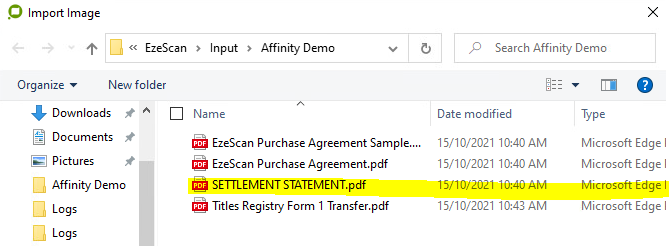
- The document is displayed in the EzeScan Viewer.
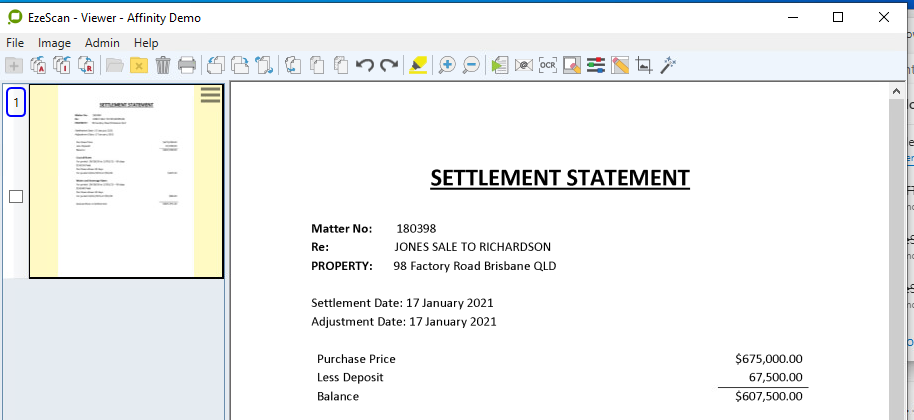
- Press F4 (Function Key F4) to start registering the document. The field indexing panel appears.

- Followed quickly by the matter search form.
You can enter some search data and get a list of matching results.
- We choose Matter File Number 2030434 and pressed OK.
The matter Details have been entered in the Matter KFI field. Behind the scenes we are keeping track of the Matter GUID.
- The user is guided to the Document Name field. This value will be used as part of the name applied to the document when it is uploaded into Lexis Nexis. The user can either type free text into this field, or use the OCR pen to rope off some text on the image to use as part of the document name.



9.The user is guided to the Description field. This value will be used as the Description metadata applied to the document when it is uploaded into Lexis Nexis. The user can either type free text into this field, or use the OCR pen to rope off some text on the image to use as part of the document name.

10. The user is guided to the Author Field. This value will be used as the Author metadata applied to the document when it is uploaded into Lexis Nexis. They click in the field and a drop down list of Authors from LexisNexis Affinity appears and they choose one value from the list.
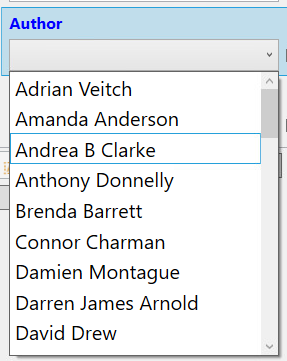

11. The operator is now guided to the Folder field, they click in the field and a list of sub folders available in Matter 2030434 appears. Choose one of the folders.
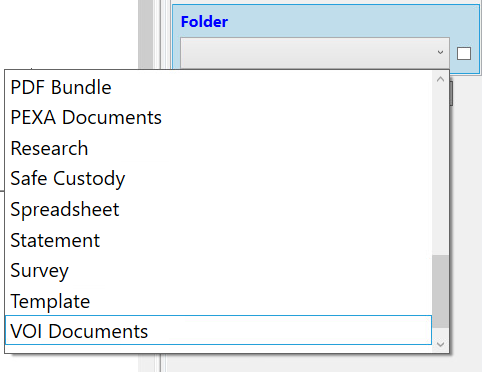
We choose the Statement folder.

12. All the required metadata has been entered. The user presses the Submit button.

13. The document gets uploaded to Lexis Nexis.
Start the LexisNexis Affinity desktop client.

Go to Matter 20303434. The document called Settlement Statement has been saved in the sub folder Statement against this matter.
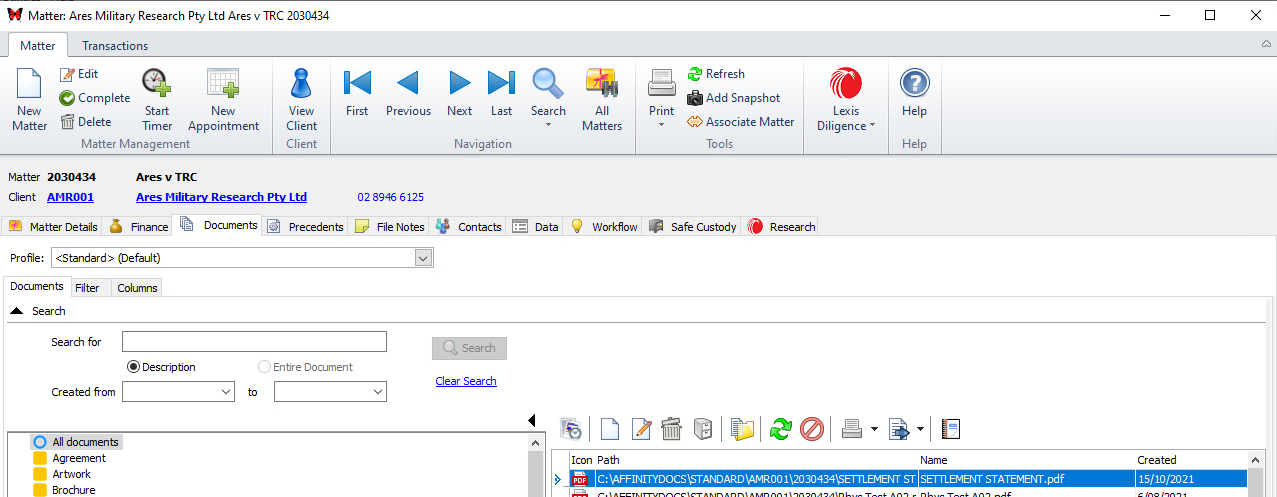
If you scroll right on this document you will see the properties such as Description and Author have been set.

If you double click on the document the PDF will be displayed.
